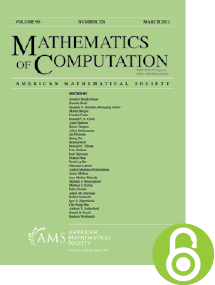Conditioning of finite element equations with arbitrary anisotropic meshes
HTML articles powered by AMS MathViewer
- by Lennard Kamenski, Weizhang Huang and Hongguo Xu PDF
- Math. Comp. 83 (2014), 2187-2211 Request permission
Abstract:
Bounds are developed for the condition number of the linear finite element equations of an anisotropic diffusion problem with arbitrary meshes. They depend on three factors. The first factor is proportional to a power of the number of mesh elements and represents the condition number of the linear finite element equations for the Laplacian operator on a uniform mesh. The other two factors arise from the mesh nonuniformity viewed in the Euclidean metric and in the metric defined by the diffusion matrix. The new bounds reveal that the conditioning of the finite element equations with adaptive anisotropic meshes is much better than what is commonly assumed. Diagonal scaling for the linear system and its effects on the conditioning are also studied. It is shown that the Jacobi preconditioning, which is an optimal diagonal scaling for a symmetric positive definite sparse matrix, can eliminate the effects of mesh nonuniformity viewed in the Euclidean metric and reduce those effects of the mesh viewed in the metric defined by the diffusion matrix. Tight bounds on the extreme eigenvalues of the stiffness and mass matrices are obtained. Numerical examples are given.References
- Thomas Apel, Anisotropic finite elements: local estimates and applications, Advances in Numerical Mathematics, B. G. Teubner, Stuttgart, 1999. MR 1716824
- Randolph E. Bank and L. Ridgway Scott, On the conditioning of finite element equations with highly refined meshes, SIAM J. Numer. Anal. 26 (1989), no. 6, 1383–1394. MR 1025094, DOI 10.1137/0726080
- Susanne C. Brenner and L. Ridgway Scott, The mathematical theory of finite element methods, 3rd ed., Texts in Applied Mathematics, vol. 15, Springer, New York, 2008. MR 2373954, DOI 10.1007/978-0-387-75934-0
- E. F. D’Azevedo, C. H. Romine, and J. M. Donato, Coefficient adaptive triangulation for strongly anisotropic problems, Tech. Report ORNL/TM-13086, Oak Ridge National Laboratory, 1997.
- Qiang Du, Desheng Wang, and Liyong Zhu, On mesh geometry and stiffness matrix conditioning for general finite element spaces, SIAM J. Numer. Anal. 47 (2009), no. 2, 1421–1444. MR 2497335, DOI 10.1137/080718486
- Alexandre Ern and Jean-Luc Guermond, Theory and practice of finite elements, Applied Mathematical Sciences, vol. 159, Springer-Verlag, New York, 2004. MR 2050138, DOI 10.1007/978-1-4757-4355-5
- Isaac Fried, Bounds on the spectral and maximum norms of the finite element stiffness, flexibility and mass matrices, Internat. J. Solids Structures 9 (1973), 1013–1034 (English, with Russian summary). MR 345400, DOI 10.1016/0020-7683(73)90013-9
- David Gilbarg and Neil S. Trudinger, Elliptic partial differential equations of second order, Classics in Mathematics, Springer-Verlag, Berlin, 2001. Reprint of the 1998 edition. MR 1814364
- F. Hecht, Bamg: Bidimensional anisotropic mesh generator, http://www.ann.jussieu.fr/hecht/ftp/bamg/.
- Nicholas J. Higham, Accuracy and stability of numerical algorithms, Society for Industrial and Applied Mathematics (SIAM), Philadelphia, PA, 1996. MR 1368629
- Weizhang Huang, Measuring mesh qualities and application to variational mesh adaptation, SIAM J. Sci. Comput. 26 (2005), no. 5, 1643–1666. MR 2142589, DOI 10.1137/S1064827503429405
- Weizhang Huang, Metric tensors for anisotropic mesh generation, J. Comput. Phys. 204 (2005), no. 2, 633–665. MR 2131856, DOI 10.1016/j.jcp.2004.10.024
- Weizhang Huang, Mathematical principles of anisotropic mesh adaptation, Commun. Comput. Phys. 1 (2006), no. 2, 276–310.
- Weizhang Huang, Lennard Kamenski, and Jens Lang, A new anisotropic mesh adaptation method based upon hierarchical a posteriori error estimates, J. Comput. Phys. 229 (2010), no. 6, 2179–2198. MR 2586243, DOI 10.1016/j.jcp.2009.11.029
- Weizhang Huang and Robert D. Russell, Adaptive moving mesh methods, Applied Mathematical Sciences, vol. 174, Springer, New York, 2011. MR 2722625, DOI 10.1007/978-1-4419-7916-2
- L. Kamenski, A study on using hierarchical basis error estimates in anisotropic mesh adaptation for the finite element method, Eng. Comput. 28 (2012), no. 4, 451–460.
- Xianping Li and Weizhang Huang, An anisotropic mesh adaptation method for the finite element solution of heterogeneous anisotropic diffusion problems, J. Comput. Phys. 229 (2010), no. 21, 8072–8094. MR 2719161, DOI 10.1016/j.jcp.2010.07.009
- J. R. Shewchuk, What is a good linear finite element? Interpolation, conditioning, anisotropy, and quality measures, http://www.cs.cmu.edu/~jrs/jrspapers.html\#quality, 2002.
- A. J. Wathen, Realistic eigenvalue bounds for the Galerkin mass matrix, IMA J. Numer. Anal. 7 (1987), no. 4, 449–457. MR 968517, DOI 10.1093/imanum/7.4.449
Additional Information
- Lennard Kamenski
- Affiliation: Department of Mathematics, the University of Kansas, Lawrence, Kansas 66045
- Address at time of publication: Weierstrass Institute, Mohrenstr. 39, 10117 Berlin, Germany
- Email: kamenski@wias-berlin.de
- Weizhang Huang
- Affiliation: Department of Mathematics, the University of Kansas, Lawrence, Kansas 66045
- MR Author ID: 326320
- Email: whuang@ku.edu
- Hongguo Xu
- Affiliation: Department of Mathematics, the University of Kansas, Lawrence, Kansas 66045
- Email: xu@math.ku.edu
- Received by editor(s): January 17, 2012
- Received by editor(s) in revised form: September 8, 2012, September 17, 2012, and January 4, 2013
- Published electronically: March 5, 2014
- Additional Notes: This work was supported in part by the DFG (Germany) under grants KA 3215/1-1 and KA 3215/2-1 and the National Science Foundation (U.S.A.) under grants DMS-0712935 and DMS-1115118.
- © Copyright 2014
American Mathematical Society
The copyright for this article reverts to public domain 28 years after publication. - Journal: Math. Comp. 83 (2014), 2187-2211
- MSC (2010): Primary 65N30, 65N50, 65F35, 65F15
- DOI: https://doi.org/10.1090/S0025-5718-2014-02822-6
- MathSciNet review: 3223329


